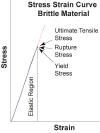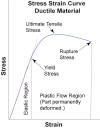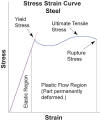| Unit Plan | Practice Test | Study Guide |
Objectives
Introducing and Classifying Materials
- Define stress and explain how it is different from pressure although both use the same units.
- Stress = (force) / (unit of area) at any given point inside an object
- Pressure = (force) / (unit of area) applied to the outside surface of an object
- Pressure is an external load. Stress is an internal condition resulting from external loads of forces and pressures.
-
Define strain: the ratio of a change in dimension to the original value of that dimension.
-
Calculate a tensile or compressive stress given a force and area.
-
Calculate a tensile or compressive strain given an original dimension and the change in the dimension.
-
Mechanical Properties
tensile strength - the amount of tensile stress a material can withstand before failure
yield stress - max stress before permanent deformation
ultimate tensile stress - max stress before catastrophic failure
rupture stress - max stress at catastrophic failure
stiffness - modulus of elasticity or Young's modulus
toughness - resistance to abrasion and cutting. Work required to make a material fail catastrophically. Tough materials are generally not brittle.
ductility - ability to extrude
malleability - ability to shape plastically. Note: the IB syllabus makes a special point to make a distinction between ductility and malleability. For all practical purposes. ductile materials are also malleable.
-
Explain a design context where each of the above properties is an important consideration.
|
 |
 |
 |
- Explain the relationship of the 2 most common structural members (beams and columns).
- Beams : horizontal
- Columns: vertical
- Explain how both modulus of elasticity and moment of inertia are related to stiffness.
- Modulus of elasticity or Young’s modulus (a material property) - directly proportional to stiffness
- Area Moment of inertia (a design property) - directly proportional to stiffness
-
Calculate the Young’s modulus of a material.
= stress / strain(Young’s modulus)
- Calculate area moment of inertia for a beam with a rectangular cross section.
- I 0 = (bh3) / 12
- where:
- I 0 = Area Moment of Inertial for a rectangular cross section of a beam
- b = width
- h = height in the direction of the load
- Define elastic stability (the tendency of a structure to resist buckling) and state why it is an important consideration in design.
- Give examples of elastic instability.
- External pressure applied to a plastic soft drink bottle's exterior
- Long thin columns